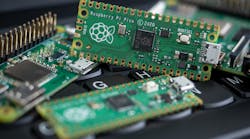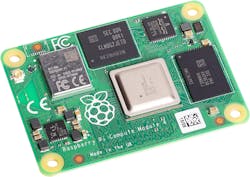This article is part of TechXchange: Raspberry Pi.
What you’ll learn
- The importance of flexibility for Industry 4.0 systems.
- The benefits of using network processing in an industrial environment.
- Advantages of using Raspberry Pi in an Industry 4.0 setting.
Industry 4.0 is a movement that has important ramifications for the architecture of industrial-computing systems. Crucial to Industry 4.0’s success is the merging of information technology (IT) with the operational technology (OT) that coordinates machine tools and process control systems on the shop floor. This is where the Raspberry Pi platform can step in to accelerate that integration process.
Increased communication between those two halves of a manufacturing business makes it possible for suppliers to react to market changes much faster. A second driver is the use of IT-OT integration to control processes in the manufacturing plant in a far more data-driven manner.
Instead of building fixed production lines where components flow through a series of predetermined steps as the product is assembled, the route is determined in real-time based on the requirements of the product and the availability of production machinery at that time. Two variants may be processed by different machines or manufacturing cells based on which components need to be integrated and the finish applied to each of them.
In principle, each finished product that emerges from the factory is customized to the buyer’s specific requirements. Mass customization is perceived to be a driver of increased profitability and market share for the companies that embrace it.
Industry 4.0 Flexibility is Essential
Flexibility is a critical factor that applies as much to the computing infrastructure overseeing the shop floor as to the machine tools and systems transporting work in progress to the different manufacturing cells.
In the past, the focus was on islands of self-contained automation based around machines and robots running fixed programs to complete specific tasks. Industry 4.0 systems need a much greater degree of coordination not just across the factory floor, but with the back-office systems that schedule and dispatch orders. At the same time, the faster networks required to support this IT-OT integration can be used to enhance the functionality of the machines and robots already in the plant.
In this environment, it becomes possible to run tasks that need higher processing power without demanding major upgrades to the industrial computers and control systems attached to the machine tools. An example is AI-assisted visual inspection to check the quality of assembly or coatings.
Instead, the tasks can be passed to flexible computers on the shop floor in situations where latency is important. Alternatively, if the local processing is insufficient, tasks could be passed to systems in the cloud, with local processing power used to compress the images and videos to minimize transfer time and cost.
The systems may determine the best approach to take in real-time to balance the use of local compute resources against response times. If a problem is found with a coating process by a relatively simple AI model running on a local system, the data may be passed onto the cloud for analysis to check that it’s not a fault with the machinery or the raw materials.
Networked Processing Improves Product Quality
Using networked processing, it becomes easier to augment manufacturing cells with additional sensors and algorithms that can be used to improve overall quality. For example, changes in temperature and humidity can affect chemical processes that ultimately alter the paint quality or adhesion between surfaces.
Instead of upgrading machinery to include these sensors, adopters of Industry 4.0 practices can attach the sensor interfaces to computer modules that process the data into forms usable with the existing machine tools. British bicycle manufacturer Brompton adopted such an approach at its factory. The company used Raspberry Pi modules (see figure) to augment product tracking around the plant without having to change the core production machinery. It now has more than 100 low-cost Pi modules in the plant wherever additional sensing and data-capture facilities are needed.
In Singapore, electronics manufacturing services specialist Jabil adopted the Raspberry Pi as its core hardware platform. Jabil’s factory digitalization program enables applications to be easily developed, tested, and deployed securely onto the shop-floor systems no matter where they’re located.
The common thread in these use cases for the Raspberry Pi lies in the high degree of software compatibility between different versions of the hardware and the core capabilities of the hardware itself. That makes it far easier to move applications to where they’re required or where compute resources are available.
Raspberry Pi and HW/SW Integration
The Raspberry Pi has key advantages for the next stage in Industry 4.0. Networks of low-cost but high-capability computers must integrate to form a factory data center where applications can move to where they’re needed and even migrate from one system to another as demands change.
In this environment, software tools and components originally developed for cloud data centers are adapted for use in systems running at the edge, whether these edge systems are attached directly to production machinery, located in cabinets on the factory floor, or situated in micro data centers close by.
Based on the Cortex-A series of microprocessor cores developed by Arm, every Raspberry Pi is a multicore computer with a full memory-management unit that includes support for operating systems such as Linux. These operating systems rely on virtual-memory support as well as a rich complement of high-speed I/O ports, all of which can be powered through a convenient USB port.
The Raspberry Pi 4, for example, is based around a Broadcom quad-core SoC with 1 MB of shared level-two cache, combined with dual HDMI video outputs to support operator interfaces and Gigabit Ethernet.
The support for Linux inherent to the Raspberry Pi is vital to the ability of industrial customers to access the development and deployment benefits of cloud-computing technologies. A key element of today’s cloud systems is virtualization and containerization. Virtualization provides a way to separate applications from each other more effectively than if they’re hosted by the same operating system.
Under virtualization, applications running in one operating system can’t access the memory of those running in another. All accesses to I/O or memory outside its own virtual address space is intercepted by a hypervisor.
That’s a major advantage in industrial systems where some software will be critical to a machine’s function but may need to run alongside third-party software to provide other functions. If updates are needed to one, they can be performed without affecting the other components.
Furthermore, the support for TrustZone inherent to the Arm Cortex-A architecture provides mechanisms for checking the authenticity of software images before they’re even installed, as well as controlling their access to I/O at runtime.
Pi Delivers Cost-Effective Containerization and Orchestration
Virtualization imposes an overhead on the processor because of the need to intercept memory and I/O accesses. In response, the cloud-computing industry developed the more resource-efficient technology of containerization. A number of security features are built directly into Linux that can be used to prevent applications from corrupting memory outside their own address space, and they don’t incur the overhead of hypervisor actions.
A second important feature of container technologies, such as Kata or Docker, is that it’s possible to package all of the libraries and system-level functions needed by an application into one that’s transferrable to any compatible machine on the network. Those libraries may be completely different from those needed by a container running on the same machine. As the container isolates the application from hardware and system-software differences, the result is a mechanism for ensuring that applications can run wherever there are spare compute resources.
In the cloud, Kubernetes, an open-source orchestration tool created by Google, is used to load, run, move, and remove containers automatically based on rules set by systems administrators. Similar tools are now moving to edge systems through projects such as Arm’s Project Cassini and others.
The combination of containerization and orchestration enables industrial users to maximize the use of their computer systems and make them futureproof. New capacity can be added easily through the addition or upgrading of processor modules.
With the Raspberry Pi platform, they can accomplish this in a highly cost-effective manner. And they can take advantage of the built-in I/O and networking capabilities to ensure all systems in this distributed industrial data center can communicate with each other.
The result is that Raspberry Pi is far more than a low-cost platform for high-speed processing. Thanks to the migration of cloud technologies into the manufacturing space, it can be the basis for the industrial data center that’s needed to unify IT and OT under the Industry 4.0 umbrella.
Read more articles in the TechXchange: Raspberry Pi.

